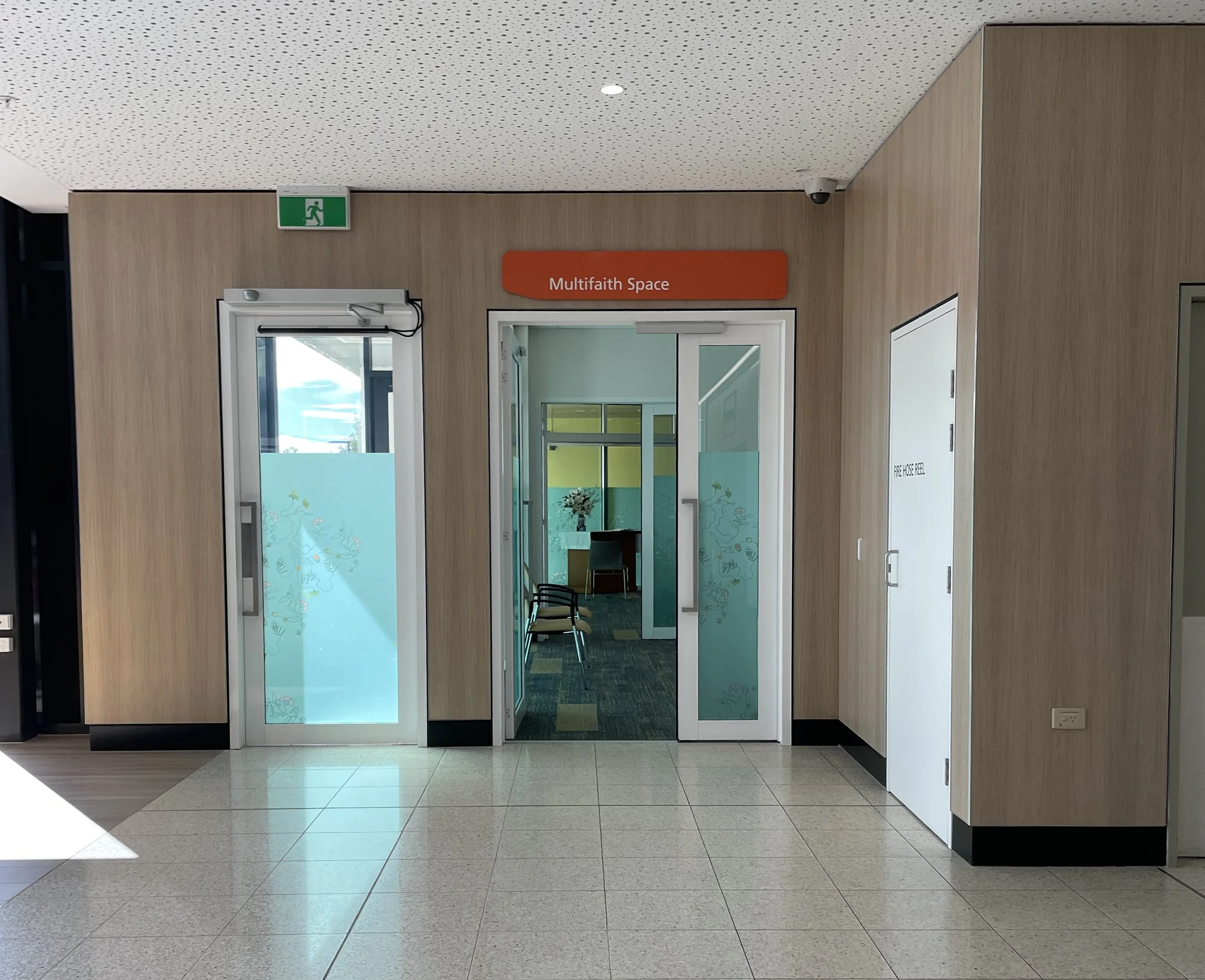Multi-faith Space
The flowing nature of the Murrumbidgee River and the bark of the scribbly gum has been the inspiring source of the pattern created for this space.
Client:
Murrumbidgee Local Health District
Surface:
Glass window sets (two-sided points of view being inside and outside)
Substrate:
Adhesive graphic vinyl
Canvas size:
1600mm (height), wrapping space of approx. 20.5mm (width)
Location:
Wiradjuri Country, Wagga Base Hospital - Multi-faith space
Murrumbidgee Local Health District (MLHD) spans 125,243 square kilometres across southern New South Wales.
The communities within MLHD consist of approximately 245,196 people in communities large and small across the region. Within this population, multiculturalism in the region is diverse, with one in 12 people born overseas, one in 18 born in a non-English speaking country and one in 20 people identifying as Aboriginal or Torres Strait islander. (Source, 2016 Census).
With this audience in mind, it is recommended the artwork encompass generic themes which address diversity and aim to engage effectively and with minimal disruption to a typical hospital visit.
By selecting generic themes, artwork has the ability to connect with people in a variety of ways, enhancing people’s experiences, as they navigate their way through the building.
The recommended themes are:
• Country;
• Community spirit;
• Environment (including the Murrumbidgee River, native flora and fauna); and
• Recognition of our people and our unique story, e.g.: History, art, culture, sport, education, innovation and agriculture.
“
Whenever I’m in the space, and see the artwork, I’m reminded of that day, and how connected I felt to the people and place.”
Environmental insights
Space purpose: To serve the spiritual needs of those who work, visit and receive care in the hospital
Artwork outcome: Compassionate and calming. Connection and belonging.
Theme: Environment (including the Murrumbidgee River, native flora and fauna)
Important to note: The window sets vary in size, width and have silver mullions, compared to the style of window sets in the stage three redevelopment, as this space was originally the hospital cafeteria.
The Eucalyptus (gum) dominates our landscapes from the bush to our backyards, paddocks, parks and pavements. One of the most distinctive features of Eucalypts is the bark, as they help to distinguish between each species. The scribbly gum has inspired the illustrative style within the illustrations of this project.
Acacia (wattle) trees are native to the regions surrounding MLHD and are can be viewed inside from the windows surrounding the hospital.
When in flower, the golden wattle displays the national colours, green and gold. As one species of a large genus of flora growing across Australia, the golden wattle is a symbol of unity. The resilience of wattle represents the spirit of the Australian people.
Ginkgo biloba reminds us of our luminous nature as we make peace with the known and unknown aspects of life and death.
In stillness, we are encouraged to sense the beauty of our inner and outer self.
The Murrumbidgee River is central to MLHD.
Water is an important resource and its health influences our farmers, animals and the nation.
The Root Chakra is responsible for our feelings of being grounded, safe and secure. Ashwagandha, is an herb that has powerful root chakra cleansing properties.
Ashwagandha is a deeply strengthening and nourishing herb that reduces stress, helps increase blood flow and relieves anxiety and depression. Source.
Due to the unique stages of plant development, the illustrations for each are included.
Borage grows well within the MLHD climate and has a distinct five petalled flower. It is an herb that instills a sense of courage and buoyancy that helps one rise above difficulties.
Bringing it all together
Due to the varied sizes of each window, and the spaces transitioning from the window materials of the previous redevelopment to the new window materials, a primary palette of greens is suggested, with bright highlights to complement.
“To address the audience and environmental insights, the flowing nature of the Murrumbidgee River and the bark of the scribbly gum has been the inspiring source of the pattern created for this space.
This pattern connects the overarching themes and spiritual symbolism together to install a sense of calm and compassion to the audience using the space.”
With a height of 1600mm (1.6m), the average height of the audience will still be able to see the light coming in from each window set; however, the substrate will block out traffic in the car park and foot traffic coming to and from the car park, the mental health unit and the emergency department to create a more private space.













